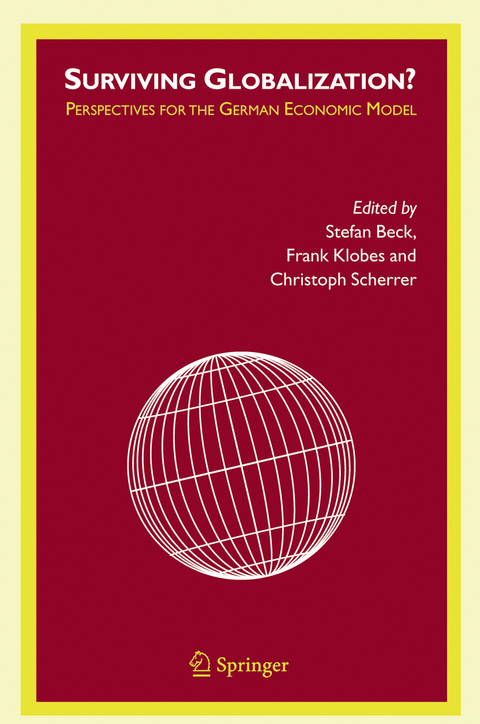
Surviving Globalization?
Perspectives for the German Economic Model
Seiten
2005
Springer-Verlag New York Inc.
978-1-4020-3063-5 (ISBN)
Springer-Verlag New York Inc.
978-1-4020-3063-5 (ISBN)
Presents the economic trends, institutional changes and governmental reforms, ranging from corporate governance and industrial relations to macroeconomic policies, and from the welfare state to European integration. This book deals with the perspectives informing the reforms and raises questions about the feasibility of institutional transfer.
society, and state (Streeck, 1999; Simonis, 1998). Interspersed between these most commonly named elements are the following: First, the high political integrating force of the German Model after WWII was based on the adoption and transformation of corporatist political structures from National Socialist Germany. Liberal capitalism was (re)introduced under political competition between Christian Democrats and Social Democrats, who eventually found common ground in the politically mediated compromise between capital and labor: “This compromise was negotiated and institutionalized at a time when the communist wing of the workers movement and the authoritarian voices of German capital – for various reasons – were excluded from political participation” (Streeck, 1999, p. 15; translation: SB). The partnership between firms and unions manifested itself in manifold institutional structures. Apart from the social partners’ autonomy in matters of wage policy, worker codetermination at plant level and in operations is regarded as one of the special achievements of the German Model and has contributed substantially to social peace. The political coordination forms of concerted action, round tables, as well as modernization and crisis cartels gave birth to a highly complex political decision-making structure which, based on a federalist setup, has rightly been called “negotiation state” (Esser, 1998, p. 123). Second, the material foundation of this “Social Democratic class compromise” (Buci-Glucksmann & Therborn, 1981) consisted in the Federal Republic’s – in the words of Göste Esping-Andersen – “conservative-liberal” form of welfare state.
society, and state (Streeck, 1999; Simonis, 1998). Interspersed between these most commonly named elements are the following: First, the high political integrating force of the German Model after WWII was based on the adoption and transformation of corporatist political structures from National Socialist Germany. Liberal capitalism was (re)introduced under political competition between Christian Democrats and Social Democrats, who eventually found common ground in the politically mediated compromise between capital and labor: “This compromise was negotiated and institutionalized at a time when the communist wing of the workers movement and the authoritarian voices of German capital – for various reasons – were excluded from political participation” (Streeck, 1999, p. 15; translation: SB). The partnership between firms and unions manifested itself in manifold institutional structures. Apart from the social partners’ autonomy in matters of wage policy, worker codetermination at plant level and in operations is regarded as one of the special achievements of the German Model and has contributed substantially to social peace. The political coordination forms of concerted action, round tables, as well as modernization and crisis cartels gave birth to a highly complex political decision-making structure which, based on a federalist setup, has rightly been called “negotiation state” (Esser, 1998, p. 123). Second, the material foundation of this “Social Democratic class compromise” (Buci-Glucksmann & Therborn, 1981) consisted in the Federal Republic’s – in the words of Göste Esping-Andersen – “conservative-liberal” form of welfare state.
Acknowledgements.- 1. Introduction (Stefan Beck, Frank Klobes and Christoph Scherrer).- 2. Can Germany Learn from the USA? (Christoph Scherrer).- 3. After the Miracle (Stefan Beck).- 4. The Dynamics of Industrial Restructuring (Frank Klobes).- 5. The German Way (Michael Fichter).- 6. Disentangling Deutschland AG (Christian Kellermann).- 7. Transforming the Welfare State (Kai Mosebach).- 8. Erosion of the Tax Basis (Kai Mosebach).- 9. European Integration (Gülay Çaglar).- 10. Explaining the Dynamics of Red-Green Economic Reforms (Stefan Beck, Christoph Scherrer).- 11. Conclusion (Stefan Beck, Frank Klobes and Christoph Scherrer).- Subject Index.
| Erscheint lt. Verlag | 4.4.2005 |
|---|---|
| Zusatzinfo | VII, 243 p. |
| Verlagsort | New York, NY |
| Sprache | englisch |
| Maße | 155 x 235 mm |
| Themenwelt | Sozialwissenschaften ► Politik / Verwaltung ► Politische Theorie |
| Sozialwissenschaften ► Soziologie | |
| Wirtschaft ► Betriebswirtschaft / Management | |
| Wirtschaft ► Volkswirtschaftslehre ► Makroökonomie | |
| ISBN-10 | 1-4020-3063-0 / 1402030630 |
| ISBN-13 | 978-1-4020-3063-5 / 9781402030635 |
| Zustand | Neuware |
| Haben Sie eine Frage zum Produkt? |
Mehr entdecken
aus dem Bereich
aus dem Bereich
Geschichte, Vordenker, Organisationen
Buch | Softcover (2023)
C.H.Beck (Verlag)
CHF 18,90
Hannah Arendts Lektionen in Liebe und Ungehorsam
Buch | Hardcover (2024)
C.H.Beck (Verlag)
CHF 39,90
Buch | Softcover (2024)
Mohr Siebeck (Verlag)
CHF 54,60


